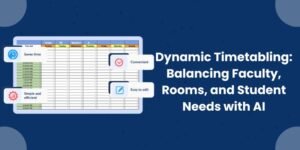Implementing an ERP (Enterprise Resource Planning) system in an educational institution can be a game-changer. From streamlining administrative tasks to enhancing internal communication, ERP brings a level of efficiency that manual processes simply can’t match.
Yet, many education leaders hesitate to adopt ERP solutions due to a handful of myths and misconceptions. These myths often stem from outdated assumptions or a lack of exposure to modern ERP platforms designed specifically for schools and colleges.
In this blog post, we bust some of the most common ERP myths that are holding institutions back—and show why now is the right time to go digital.
Myth #1: ERP is Too Expensive for Schools and Colleges
Truth: Modern education ERPs are scalable and cost-effective.
Many leaders believe that ERP systems are only for large corporations or elite institutions with massive budgets. While this may have been partially true a decade ago, today’s ERP solutions are built with affordability and scalability in mind.
Cloud-based ERPs offer subscription models, meaning:
- No large upfront hardware investment
- Flexible pricing based on institution size
- Long-term savings through automation and reduced manpower needs
Think of ERP as an investment, not an expense. The ROI comes in the form of saved time, improved efficiency, reduced errors, and smarter decision-making.
Myth #2: ERP is Too Complex for Staff to Use
Truth: ERP systems today are built for everyday users, not just tech experts.
Another common concern is that staff may struggle to adapt to a new system, fearing it will slow them down or increase workload.
But the truth is:
- Modern ERPs have intuitive, user-friendly dashboards
- They offer role-based access, meaning teachers, admin staff, and finance officers see only the features relevant to them
- Training and support are often part of the implementation package
With just a few hours of orientation, staff can start navigating the ERP confidently. And once they’re familiar, most find it easier than juggling Excel files and paperwork.
Myth #3: We Can Manage Everything With Excel
Truth: Excel is not built for institutional-scale operations.
While Excel is a powerful tool, it wasn’t designed to manage the complexity of school data across departments. Relying solely on spreadsheets results in:
- Data duplication
- Version control issues
- Human errors
- Lack of audit trails
- Limited automation
An ERP system, on the other hand:
- Integrates real-time data across academics, finance, HR, and operations
- Provides a single source of truth
- Automates repetitive tasks like attendance tracking, fee reminders, and report generation
ERP frees up staff to focus on strategic and student-focused work instead of data entry and reconciliation.
Myth #4: ERP is Only Useful for Large Institutions
Truth: Even small schools and colleges benefit from ERP.
Institutions of all sizes face similar operational challenges:
- Tracking student progress
- Managing finances
- Communicating with stakeholders
- Ensuring compliance
A good ERP helps schools, regardless of size, by:
- Providing structure to growing administrative needs
- Offering dashboards to help principals and trustees make decisions faster
- Saving time on repetitive tasks
In fact, small institutions often benefit the most from ERP because they may have fewer administrative staff and tighter margins—efficiency matters even more.
Myth #5: ERP is Only for Administrative Tasks
Truth: ERP supports both academic and operational functions.
There’s a widespread belief that ERP is only for fee tracking, payroll, or stock inventory. But education ERP systems are much broader in scope. They can also:
- Manage student records and progression
- Track attendance and exam results
- Support timetabling and scheduling
- Facilitate internal communication
- Generate customised academic and financial reports
Some ERP systems even come with built-in tools for learning management, student-parent portals, and digital notice boards.
In other words, ERP supports the entire ecosystem of an institution.
Myth #6: Implementation is Disruptive and Time-Consuming
Truth: With the right partner, implementation is smooth and modular.
Yes, ERP implementation requires time and planning—but it doesn’t have to be a nightmare. Reputable ERP vendors follow a phased, collaborative rollout process that includes:
- Initial data migration
- Staff training
- Pilot testing
- Full deployment
- Ongoing support
Many institutions go live in just a few weeks. You can also choose to implement features gradually, starting with core modules like student data and finance, and expanding over time.
Implementation is a one-time effort that leads to long-term gains in stability and efficiency.
Myth #7: Data is Not Secure on Cloud-Based ERP
Truth: Cloud ERP systems often offer better data security than local servers.
Cybersecurity is a legitimate concern—but cloud ERP platforms are built with this in mind. Reputable providers offer:
- End-to-end encryption
- Role-based data access
- Regular backups and data recovery options
- Compliant with national and international data protection laws
In fact, keeping data in local files or unencrypted servers is riskier, as it makes institutions vulnerable to data breaches or accidental loss.
Myth #8: ERP Reduces the Role of Teachers or Staff
Truth: ERP supports staff—not replaces them.
The goal of ERP is to simplify workflows, not eliminate roles. For example:
- Teachers spend less time on paperwork and more on teaching.
- Admin staff no longer chase fee records manually.
- Principals get real-time performance dashboards without waiting for reports.
ERP empowers staff by giving them the tools to do their jobs better. It reduces repetitive tasks and gives them space to focus on what matters—students, strategy, and service.
Key Takeaways for Education Leaders
- ERP is not just a tool—it’s a strategic enabler
- Modern ERP systems are affordable, secure, and easy to use
- They can be tailored to institutions of all sizes and types
- ERP improves communication, accountability, and decision-making
- The benefits far outweigh the fears—especially in the long run
In today’s digital-first world, education leaders cannot afford to rely on outdated systems. ERP is no longer a luxury; it’s a necessity for efficient, transparent, and future-ready institutions.
By busting these myths, we hope to encourage more schools and colleges to explore ERP adoption with an open mind and informed perspective.
Still unsure? Start small. Choose a few modules. Observe the transformation. You might just wonder why you waited this long.












